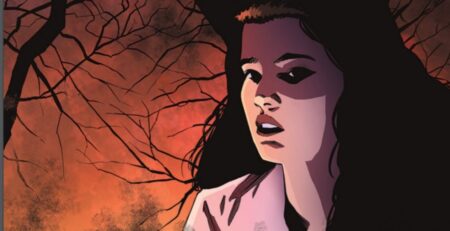
Hecate’s Will is published by Black Mask Entertainment, Inc., and is written and illustrated by Iolanda Zanfardino. Rebecca has spent the last several years known to a small underground following as the street artist Hecate. Over the years, she has tried to put out a message that she had hoped would have an impact on the flawed, failing culture she found surrounding her in the streets of the city she loves. But, after her years of toil, she feels exhausted, empty, and defeated. Now, she prepares one final series of pieces to be her swan song. A final message for those who may one day think of following in her rebellious footsteps.
The overriding emotion of Hecate’s Will #1-2‘s protagonist is one of defeat. It is a feeling that many of us can undoubtedly share. As so many of the world’s problems continue to chug along, if not worsen, it is easy to feel like the proverbial speck of dust crying out into the infinite. Especially for those of us who, like Rebecca, have defined themselves through the expression of their opposition to those failings. When you reach the point where you ask if there is any point to fighting left, or if it’s finally time to hang up your spray cans and go work for your dad. Consigning yourself to an existence that you neither desire nor hold any hope for you.
This exploration of Rebecca’s inner struggle with who she is now that she has decided to end the work she has defined herself with is executed with an excellent level of nuance and care. Such questions in life are never easily solved. Rebecca’s ponderings throughout Hecate’s Will #1-2 allow the reader to understand the character deeply. While these moments of contemplation on Rebecca’s part bring a cadence to the series story that may be too slow for some, you couldn’t do the character’s thoughts justice without them.
But even amidst Rebecca’s struggles and musings about what her life’s work has meant and where she goes from here, the world isn’t completely devoid of light. Most frequently aided by her friend Mateo, Rebecca still finds specks of light despite her frustrations and failing hopes. These moments are nice reminders that everything isn’t dark and that there is still joy to be found, even when one’s life may feel like it’s crumbling away.
The art in Hecate’s Will #1-2 does a great job of delivering the high levels of emotion that the story requires, while also bringing something unique in its design. The art throughout the story is almost exclusively done in red. This goes for the linework as well as the coloring. This saturation of red makes the art instantly notable to the eye. But all this red is kept from coming on too strong through its lighter tones. This somewhat faded look feels like it reflects Rebecca’s failing energy as she muses her way through the narrative.
Lastly, we come to the letters. As the only element that isn’t tinted red, the dialogue manages to always stay clearly defined from the rest of the book’s visuals, while not being jarringly different as they provide the reader with an easy-to-follow path through the narrative.
When all is said and done, Hecate’s Will #1-2 brings a promising start to what looks to be a deep and insightful story that still allows for some joy and warmth throughout its pages. As long as you can embrace the slower pace of this book’s narrative there is a lot to take away from Rebecca’s musing on life, the world, and our places in it.
Hecate’s Will #1-2 are available now.
Hecate's Will #1-2
TL;DR
When all is said and done, Hecate’s Will #1-2 brings a promising start to what looks to be a deep and insightful story that still allows for some joy and warmth throughout its pages. As long as you can embrace the slower pace of this book’s narrative there is a lot to take away from Rebecca’s musing on life, the world, and our places in it.







